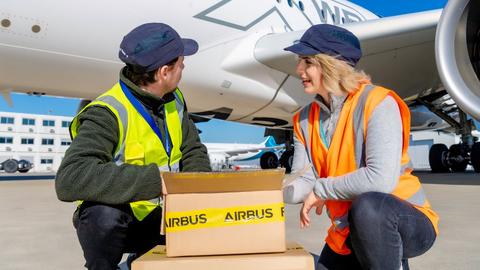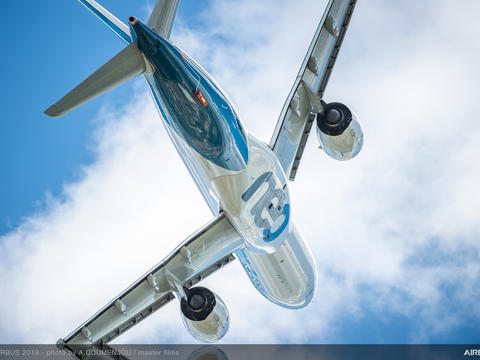Summary
Entering airline service in late 20181, the A330neo is Airbus’ latest widebody aircraft. As such the aircraft’s design benefits from the latest in 3D Computational Fluid Dynamics (CFD) modelling, incorporates new avionics systems developed for the A380 and A350 and features a reliable, fuel efficient engine specifically developed for the aircraft. To understand how the versatile, proven A330ceo has undergone a technological sea change, come take a look at the seven wonders of the A330neo.
1. All-new Wing Design
A noticeable change in the A330neo is its wing design that features a blended wingtip device integrated with a new, CFRP (Carbon Fiber-Reinforced Plastic) outer span extension, increasing the aircraft’s geometric wingspan to 64m. The new design was visualised, modelled and optimised using 3D Computational Fluid Dynamics. The enhancements involved not just the new winglet but also tuning of the wing twist, changes to the wing camber and belly fairing as well as an optimised engine/nacelle/pylon integration. The A330neo wing has an aspect ratio of 11, the highest of any airliner in production today, lowering induced drag and generating more lift at all speeds and flight phases. Overall, the new design results in substantially improved wing loading and the best possible lift-to-drag-ratio.

2. Efficient Engines
The A330neo boasts the new, highly efficient Rolls-Royce Trent 7000, an engine built on proven A350 powerplant technology. The Trent 7000 has a large 112 in (280 cm) fan, 10:1 bypass ratio, twice that of its predecessor, and, thanks to its small, high pressure-ratio core and latest, fully swept, wide-chord fan technology, delivers a 10% specific fuel consumption improvement relative to the Trent 700. The engine has already demonstrated the capability of flying on 100% SAF (Sustainable Aviation Fuel) and will receive certification to do so in the 2026 timeframe. The Trent 7000 offers a range of thrust ratings from 68k to 72k pounds, enabling customer specific optimisation for reduced operating cost. Now the production standard, but also available for upgrade to engines delivered prior to its 2022 certification, a new durability enhancement package has more than doubled the Trent 7000’s time on wing. As of March 2024, the engine has flown over 2 million flight hours, demonstrating an exceptional 99.9% dispatch reliability. Reflecting a commitment to continuous improvement, a phase 2 of the Rolls-Royce Trent 7000 Durability Enhancement Package is planned, from late 2025 through 2028, which will further increase engine time-on-wing by up to 30%.

3. Advanced Avionics and Cockpit Upgrades
The A330neo features state-of-the-art avionics and cockpit technologies, many of which are inherited from the A350. With the A350, piloting core symbology evolved from the traditional concept of ‘pitch and thrust’ to the new, intuitive parameters of ‘trajectory’ and ‘energy’. The new symbology was introduced onto the Head Up Displays (HUDs) and a new ‘harmonised Primary Flight Display’ (hPFD). The A330neo cockpit offering includes these new HUD and hPFD displays. Regarding en-route navigation, pilots will be able to use a new Satellite-Based Augmentation System (SBAS) that will become mandatory throughout North American airspace in 2025. In regions covered by SBAS, the A330neo’s SBAS Landing System (SLS) allows CAT 1 ILS (Instrument Landing System) type precision approaches without the need for ground based ILS equipment. These, and many more new cockpit systems such as the Airbus unique Runway Overrun Prevention System (ROPS), Autopilot/Flight Director Traffic Collision Avoidance System (TCAS) and wifi Electronic Flight Bag (EFB) tablet bring the A330neo cockpit in line with the latest technological advancements.
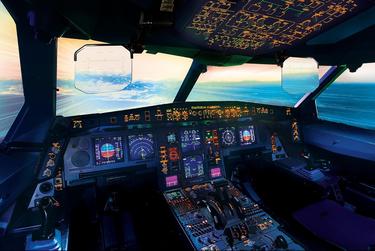
4. Enhanced Airspace Cabin
With the A330neo, passenger comfort and well-being take centre stage but the award-winning Airspace cabin also provides a superior work environment for cabin crew and enhanced branding opportunities for airlines. The bright, contemporary Airspace design imparts a relaxing feeling of spaciousness to the A330neo cabin, which is also quieter than both the A330ceo and competing aircraft alike. It also provides superior air quality in six separate temperature zones. Cabin air is renewed every 2 to 3 minutes and hospital-grade HEPA filtration removes more than 99.9% of pathogens. Full-LED ambient lighting not only helps combat jet lag but can also support airlines’ brands, and latest generation IFE provides hi-definition (4K) entertainment as well as wireless connectivity. Further enhancements scheduled through 2028 will see the introduction of new Airspace interior features. These include a new Welcome Panel lighting feature at Door 2, a customisable Hero Light, electro-dimmable windows in the area between Doors 1 and 2, and new sidewall and ceiling panels offering improved comfort. A330neo operators can select from a number of Innovative Cabin Enablers - space saving monuments (galleys and lavatories) that can increase seat count by up to 10 seats without compromising comfort.
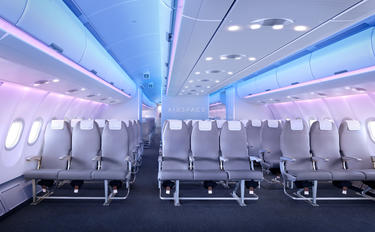
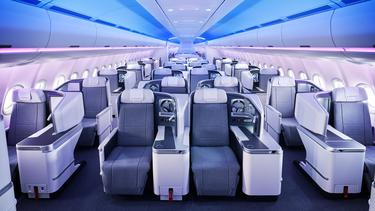
5. Extended Range
The A330neo comes with increased range capabilities compared to the A330ceo. Thanks to its improved aerodynamics and efficient Rolls-Royce engine, the A330neo burns 12% less fuel per trip than the A330ceo. Combined with the highest Maximum Take Off Weight offering of 251t, the A330neo can fly up to 1,500nm further than the A330ceo2, with the A330-900 capable of up to 7,200nm and the A330-800 8,100nm. This extended range opens up possibilities for more direct routes and the ability to connect distant cities with ease. Delta Air Lines, for example, fly their A330-900s U.S. West Coast to Europe and trans-Pacific from the U.S. to Asia. But the A330neo is about more than just range - it’s about versatility. Both aircraft offer lower weight variants, starting at 200t for the A330-800 and 205t for the A330-900, in incremental 5t steps up to 220t. These lower weight variants reduce landing and navigation costs for airlines who do not require the range afforded by higher MTOWs. Starting in late 2025 and throughout 2028, this operational flexibility will be further improved with a Low Speed Performance enhancement package increasing TOW by up to 7 tonnes at obstacle-limited airports, as well as the certification of an extended envelope for take-off and landing up to 12,500ft. The A330neo will also benefit, subject to certification, from a derated 68klb thrust version of the Trent 7000 powerplant. Resulting in higher temperature margins and longer time on wing, the 68k rating will lower engine maintenance costs by 12%. These lower costs, combined with a greater than 99% operational reliability make the A330neo the widebody regional champion.

6. Streamlined Maintenance and Operational Efficiency
Over time, design changes and knowledge of the airframe have driven down A330 maintenance costs. Compared to the A330ceo, the A330neo can today reduce airframe maintenance cost by up to 28% thanks to higher reliability, fewer fatigue tasks and extended check intervals. The A330 Maintenance Planning Document (MPD) has evolved based on the in-service experience of the nearly 1,500 highly reliable A330ceos delivered. The longer check intervals that the A330neo benefits from today result in greater network optimisation, lower turnaround times and higher aircraft availability for more revenue service. The aircraft’s new design has led to a significant reduction of fatigue tasks relative to the A330ceo as well as the deletion of all fatigue sampling tasks. The A330neo’s updated design, systems and connectivity also mean that the aircraft is equipped for today’s digital, big data driven world and can take full benefit of real-time health monitoring as well as predictive maintenance, driving unscheduled maintenance events down and revenue generating operations up.
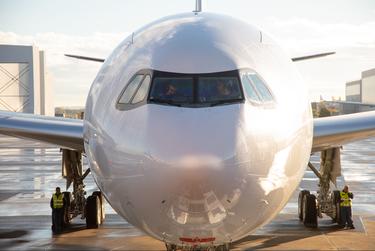
7. Lower noise and emissions
The enhanced aerodynamics of its new wing associated with the RollsRoyce Trent 7000 engine lead to the substantially improved fuel efficiency, performance and range of the A330neo. At equal seat count, the A330neo offers a 12% fuel per trip improvement over the A330ceo. With the 10 extra seats gained thanks to Airspace cabin enablers, the fuel burn per seat advantage of the A330neo is 14%. This lower fuel burn results in a corresponding reduction in CO2 emissions and in typical operations, the A330neo will produce about 9,000t less CO2 emissions per year than the A330ceo. In 2021, the A330neo was the first, and as yet only, large airliner to be certified by EASA for ICAO’s new CO2 standards that all aircraft being produced from January 2028 and beyond will need to comply with. In another first, in 2018 the aircraft became the first to be certified for ICAO’s Chapter 14 noise standards. This is achieved in no small part by the Trent 7000’s 10:1 bypass ratio that means it is 6dB quieter than the A330ceo’s Trent 700 - an almost halving of noise energy emitted compared to its predecessor.

In conclusion, the seven wonders of the Airbus A330neo make the aircraft a significant evolution from its predecessor, the A330ceo. Thanks to regular improvement packages further enhancing its efficiency, range, comfort, and technology, the A330neo continues the A330 programme’s tradition of continuous improvement. Late 2025 through 2028 will see the introduction of:
- A Low Speed Performance enhancement package, increasing TOW by up to 7 tonnes at obstacle-limited airports
- Certification of the envelope extension for take-off and landing up to 12,500ft
- Rolls-Royce Trent 7000 Durability Enhancement Package phase 2, further increasing engine time-on-wing by up to 30%
- A330-900 two tonne MTOW and MZFW increase to 253t and 183t respectively, increasing range (to 7350nm) and payload
- New Airspace Interior features, including a new Welcome Panel lighting feature at Door 2, customisable Hero Light, as well as electro-dimmable windows in the Door 1 to Door 2 area, and new sidewall and ceiling panels offering improved comfort
All of these improvements help ensure the A330neo remains the best aircraft in its category, making it a compelling choice for airlines seeking a modern, cost-effective and environmentally conscious solution for their current, and future, long-haul operations.
1 A330-900 EIS December 2018, A330-800 November 2020
2 A330-800 flies 1,200nm further than A330-200, A330-900 1,500nm more than A330-300

